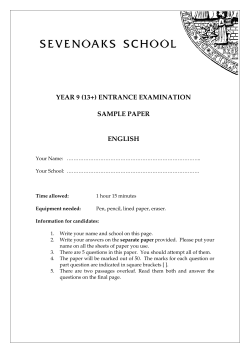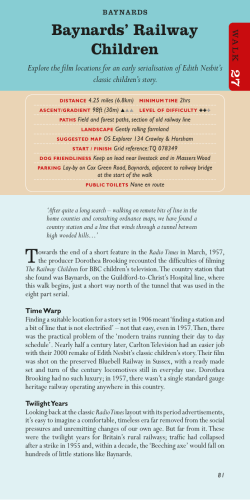
India’s first child friendly Railway – Child Protection System station
India’s first child friendly Railway station – Child Protection System Presentation by Railway Children For OHCHR expert consultation 1st November 2011 Website: www.railwaychildren.org.uk Railway Children, Company Limited by Guarantee, Registered in England & Wales, No. 3265496, Registered Office 1 The Commons, Sandbach CW11 1EG Railway Children • Railway Children is an international development agency working in the UK, India and East Africa. • Railway Children works to create and enable sustainable change in the lives of children living on streets, without care or protection. • Railway Children is delighted to have this opportunity to share with you our learning in creating and supporting a child rights protection model at Railway Stations. India and its children • 19% of world’s children live in India and almost 42% of its population are children. • It is estimated that around 170 million children are vulnerable. Which include children surviving on streets and transport terminals. • 53% of children reported having faced sexual abuse – Govt. of India “Study on Child Abuse, India 2007”. • The aggregate outlay for children schemes in union budget 2010-11 as compared to total outlay is 4.1%. • UNICEF’s (1994) estimate of 11 million street children in India, still remains widely quoted data. • Railway Children (2009) estimated that 112,000 children arrive at railway stations of India per year. • Railway Station is a critical point of intervention, intervening early to protect children from entering “street life”. Is this because there is a lack of policy and legislative framework? - NO • Article 15 of constitution of India - special laws and policies to safeguard rights of children. • The Immoral Traffic (Prevention) Act, 1956 • Child Labour (Prohibition and Regulation) Act,1986 • India signed CRC in 1992 • The Juvenile Justice (Care and Protection of Children) Act, 2000 & 2006 • Commission for Protection of the Rights of the Child Act, 2005 • Schemes and programmes:- Programme for Juvenile Justice (post 2000), Integrated programme for street children (post 2000), Child line (1996), Integrated Child Protection Scheme (2006), National policy for children (1974) Then Why? - Major challenges in Child Protection • Gaps in effective implementation of provisions of schemes and legislatives: (E.g. Uttar Pradesh has 83 Districts, but there are only 33 Govt. homes for children and only 3 for physically challenged – JJ Act provisions for Govt. home in all the districts.) • The movement of child rights protection has gained momentum in last two decades understanding of the resource requirement and implementation structure is still evolving. • Children are not a part of vote bank and hence push for enactment is weak. • Need is huge – service and infrastructure in comparison is negligible • Need for adequate and trained human resource • Multi stakeholder child protection systems led by Govt. stakeholders – a workable solution to strengthen the implementation of schemes and legislative provisions 2011 Journey of India’s first Child Friendly Railway Station 2010 2006 Railway Children Protection & Surveillance Mechanism Railways, RPF/ GRP, vendors, porters begin tracking new children @ the platform 2008-09 300+ Railway/RPF/GRP personnel pledge to make Lucknow India’s 1st CFS by 2011. NR forms Special Task Force which declares making Lucknow child friendly by 2011, its goal Child Protection Committee formed 4 Child Welfare Officers appointed @ Charbagh, India’s 1st child friendly station -Every lost/runaway child is immediately attended to. -More children avail basic facilities, reunified with families -More RPF/GRP referrals -More awareness, JJ Act trainings -No drug peddlers/beggars/pimps Participation in Vision 20-20 conference Stakeholder network very active Railways & NGOs engage in public-pvt partnership State level consultation JJ Act & Child Right trainings 1st child protection booth set up at the station Ehsaas: outreach & DIC Pre-2006 Children at Lucknow - Don’t have access to basic facilities - Addicted to sniffing ‘solution’ - Police book them under Railway Act rather than JJ Act Tunnels of Challenges Mobility of children North Eastern railways are not as active as Northern Railways Older children = ‘troublemakers’ Only new/lost children are a priority Procedural delays – e.g. transfers/orienting new staff Lucknow – Multi stakeholder Child Protection Network 1. A vigilant and responsive child protection forum 2. Trained, responsive and sensitive police 3. Effective multi stakeholder outreach – active participation from Child line (Govt. scheme) 4. Child help line displayed 5. Child protection booth at platform 1 manned 2 personnel – linked to outreach 6. 24 hr drop in centre operated by NGO (JJ Act) 7. Support system within city for disabled and terminally ill (JJ Act) 1. Child welfare officers in RPF & GRP (JJ Act) 2. Outreach at station linked to CWC in the city (JJ Act) 3. Govt. home for children linked for medium term care and protection (JJ Act) 4. Need based residential vocational training (ICPS) PLANNING AND MONITORING COMMITTEE Senior Railway & police Officials and NGO heads RAILWAY CHILDREN SURVEILLANCE AND PROTECTION CELL Station level Railway & police officials and NGO coordinators and outreach workers NGO’s SURVEILLANCE & PROTECTION NETWORK Peer Educators Child line Coolies Passenger Vendors Railway Officials Street Children Why this is a good practice & key learning This “child protection network” ensures effective implementation of various legislations and schemes in Uttar Pradesh at a macro level and Lucknow city at a micro level. • First four child welfare officers (from Railway Protection Force, Govt. Railway Police) have been appointed for Lucknow station and in all GRPs across UP- JJ Act, 2000 & 2006 •Children are referred to Child Welfare Committee by RPF & GRP for rehabilitation and reintegration - JJ Act, 2000 & 2006 (round ups stopped). • 50% increase in RPF/GRP referrals of children to EHSAAS’s drop in centre – in turn 14 % increase in the number of children being reunified in coordination with Child Welfare Committees. - JJ Act, 2000 & 2006 • Traffickers are also being intercepted and children rescued . Also, perpetrators of crime against children are arrested by police and punished. – Child labour Act and Immoral Trafficking prevention Act. No. of children etc… - include that. •EHSAAS’ (local NGO) Drop-in-centre is the first to be registered under the Integrated Child Protection Scheme so as to get Govt. aid. - Govt. scheme (access to education and development) Key Learning: - For the sustenance of multiple stakeholder initiative, it is effective if primary Govt. stakeholder (not the civil society) takes the lead.
© Copyright 2025





















